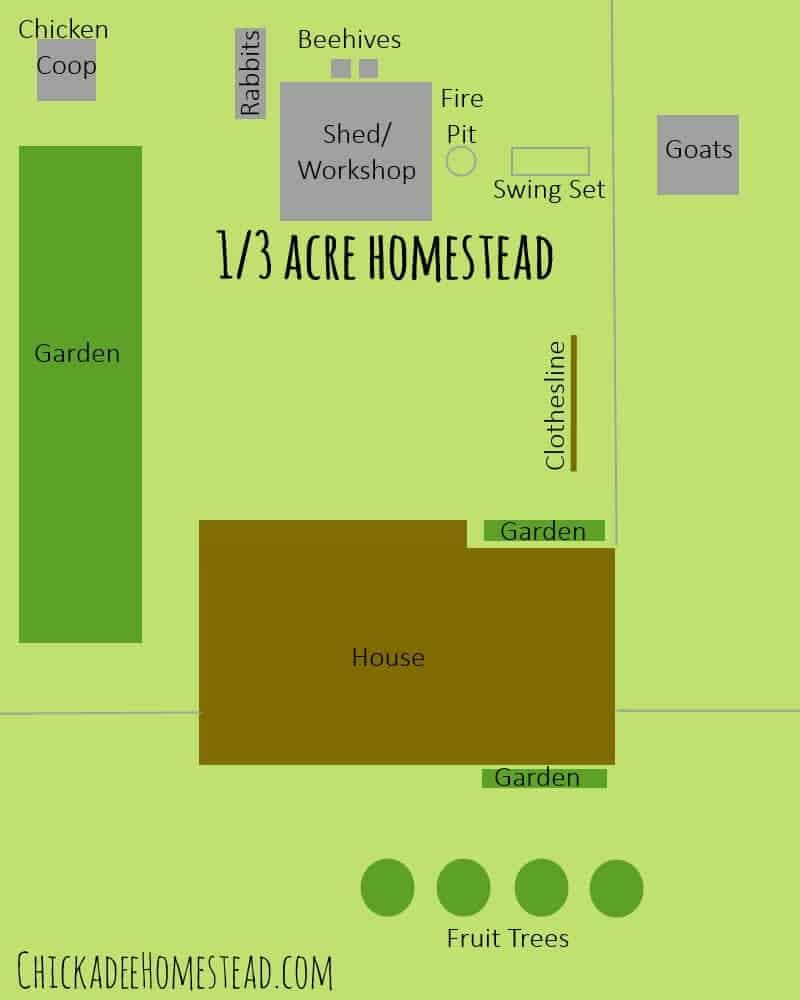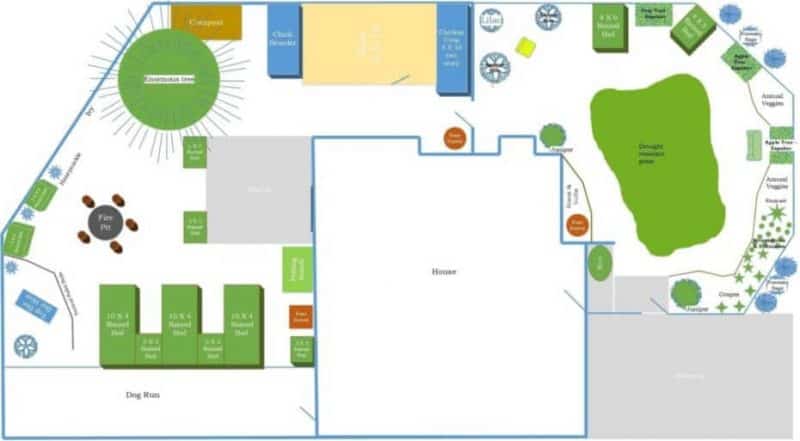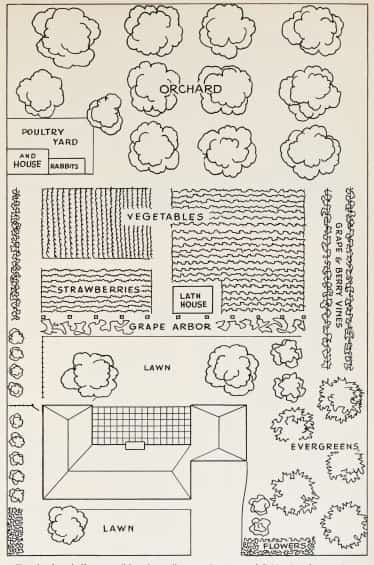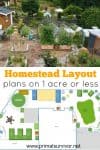You want to start homesteading but don’t have a lot of land? Lack of land is one of the biggest excuses I hear from people who’d like to become more self-sufficient but don’t get started.
I hear you because I also used to believe that homesteading required tons of land! That’s why I want to share these tiny homestead layouts with you. The homestead layout plans are 1 acre or under and help their owners achieve a considerable degree of self-sufficiency and even some income!
Read: What is homesteading?
1/3 Acre Homestead Layout

This homestead layout plan is from Lindsey at Chickadeehomestead.com. Yes, it is only 1/3 of an acre – but that is enough for the family to raise and grow 80% of their food and most of their personal care items!
How have they done it? Focusing on food sources that don’t take up a lot of space, for example, raising chickens and rabbits instead of cattle and sheep.
1/8 Acre Urban Homestead Layout

Melissa at Evergrowingfarm.com has a truly impressive homestead layout – particularly because it is an urban farm.
What started as a “postage stamp of dead earth” amongst busy streets soon became an oasis. There are:
- 165 sq. feet raised bed garden
- 260 sq. feet ground-level growing space
- Strawbale compost pile
- A dog run
- Chicken coop and two brooders
- Rainwater barrels that can hold 175 gallons
- 5 chickens (which later grew to 20 chickens)
How did they do it? It was all about smart practices like crop rotation and utilizing the space smartly. You can learn more about the urban homestead here.
½ Acre Homestead Layout

This ½ acre homestead layout comes from a 1950s brochure made by the California Agricultural Extension Service.
You’ll see that the home and living area haven’t been significantly reduced (you could put more garden space or chickens where those evergreens are!). Yet, there is still a lot of food to be reaped from the orchard and garden. Like with the first tiny homestead, rabbits and chickens have been chosen for their efficiency.
Other Tiny Homestead Layout Plans
The owners of these websites didn’t get back to me with permission to share their images. So, you’ll have to click on the website to see the tiny homestead layouts yourself. It just shows that there are many ways to improve your self-sufficiency through homesteading, even in a small space!
- 1-acre homestead from oneacrevintagehome.com
- Backyard farm layouts (1/2 to 3 acres) at weedemandreap.com
- 1-acre urban permaculture design at milkwood.net
- 2 ¼ acre homestead design at byexample.net (okay, this one isn’t under 1 acre, but I thought to include it anyway!)
The Myth that You Need a Lot of Land to Be Self-Sufficient
Before starting my homesteading journey, I thought I’d need a lot of land to achieve any degree of self-sufficiency. Then I started researching homesteading and visiting homesteads too. I was amazed at what was being done — even on the rooftops of city homes, in apartments, and in tiny backyards.
It is easy to understand why people think you need a lot of space to be self-sufficient. Giant CAFO farms and huge mono-crops dominate our country’s food production.
We are also skewed by history. In the 1800s, the minimum homestead parcel the government gave out was 320 acres. (Source)
While it certainly helps to have a lot of land, it isn’t always necessary. Modern farming techniques have made it possible to raise much more food in less space, and good planning and homestead design can go a long way.
Here’s an example of what can be done on a small homestead:
- Singing Frogs Farm: This homestead is larger at 3 harvested acres, but you’d still be surprised to learn that they generate over $100,000 per acre. The key is using sustainable methods to keep their topsoil healthy.
Where to Homestead
See here for the best states for homesteading.
Some Great Resources for Tiny Homesteads
I’m not going to lie and say that it is easy to become self-sufficient on a tiny homestead. There is a high learning curve! But, if you stick with it, you’ll be rewarded with your own food and maybe even have a medicinal garden and homemade cleaning products.
I highly recommend reading some homesteading books to get you started on your journey. Here are some of my favorites with Amazon links:
- How to Grow More Vegetables: This book discusses bio-intensive gardening methods that produce huge yields on small garden plots.
- The Backyard Homestead: This book deals with all of the logistics of planning your homestead, from where to put the chicken coops to how to set up the garden. I love that it focuses on small spaces.
- Maximizing Your Mini Farm – Self Sufficiency on ¼ Acre: There is a lot of excellent information in this book, such as soil fertility techniques, trellising, heated water platforms, and planting guides. I also like that Brett talks about getting the most out of specific veggies like carrots and peppers. You’ll also find info like making vinegar and cheese.
- Backyard Farming on an Acre (More or Less): Here is a book for people just starting homesteading. It begins with advice about purchasing land and takes you through garden planning and skills backyard farmers need to know.
Are you homesteading? How much land do you have?



I have about a quarter of an acre. The house is smack bang in the centre. The front yard currently matches all of the neighbours (perfectly manicured lawn and ornamentals). To utilise the front lawn I will need to grow food that doesn’t look like food. All I’ve come up with so far is a bayleaf hedge but that seems like a waste since I’d never have a need for that much bay leaf!
See what wild local edible plants grow naturally in your area (and actually taste good; lots of wild edibles are gross!). For example, I’ve got a lot of hogweed (Heracleum sphondylium) in my garden. It requires zero effort and is very nutritious.
Unless your in an association what would it matter. However you can co-mingle vegtables with your annual or perinial flower gardens or beds. My sister grows cherry tomatos, peppers of all kinds, eggplant and all her herbs in her front flower beds. She grew tomatoes and cucumbers in large pots growing up a trellis on either side of her house. Being creative with your small spaces will be productive
What about fruit?! Fruit trees are beautiful. Or even raspberry or blueberry bushes or if you have a spot for climbing grapes even!
Thanks for the drawings, I am looking for a plan view drawing for a 700′ deep, 300′ wide lot, incorporating roads and houses, garages, gardens and outbuildings for a 5 acre development for one of my customers. Power is at the front left edge so that will be need to be considered
I don’t want a “tiny house,” but I know I don’t need anything huge, either. My last apartment was about 700 (500?) square feet, and it was fine. Can you suggest a good size for 1/2 acre plot? 1/3 acre? — Thanks. Kathy
My home is only 550 sq. feet and there are four of us in it. Yeah, it gets tight and I’m constantly coming up with different storage solutions. So size really depends on lots of factors like your family size, whether you can build upwards, whether a basement is possible…
My parents grow berries on their septic lines. Not sure if this is a good idea but in 40 years i have never gotten sick.
You can do a container garden plot over septic areas – just set up a bunch of pots.
Were the septic tank drain you do square or bucket garden to eliminate contamination and be able to have all space available.
How do you deal with a septic tank while trying to have a tiny homestead? We have 3/4 of an acre but half of the backyard is the septic tank and drainage lines. I have read that you are not to plant anything but grass on it.
Yes this is a problem – it is not recommended to grow fruit or veg or graze animals on or near the septic tank area. As far as I know there is nothing that can be done about this. If any readers have ideas then let us know here in the comments!
You could grow in pots. #containergardening
Composting toilet to eliminate black water, then you only have gray water issues which is more manageable.
Thanks Jay
When you empty a composting toilet, where would I empty it?
What if you did raised beds in that area?
I would still be worried about contamination, a bucket garden would be a safer option.
With a properly set up multi-stage filter system, it should handle itself.
I don’t see any harm in growing very shallow rooted plants. The issue with the septic mount is plants/trees that have long roots that can effect the tank & pipes. Doing a raised bed or putting weight on it can break the pipes that you can’t see. As far as sewage at itself I don’t think you would be close enough to having a effect on the plant.